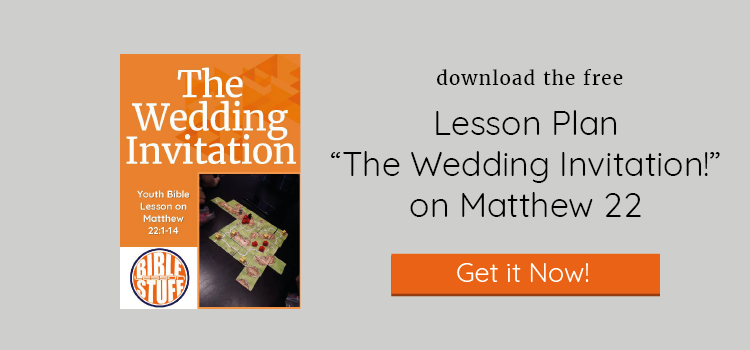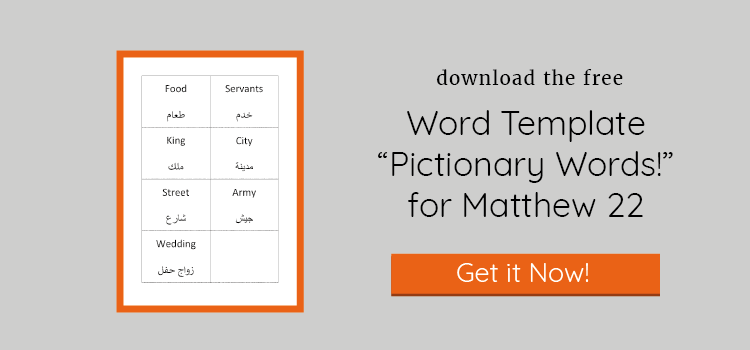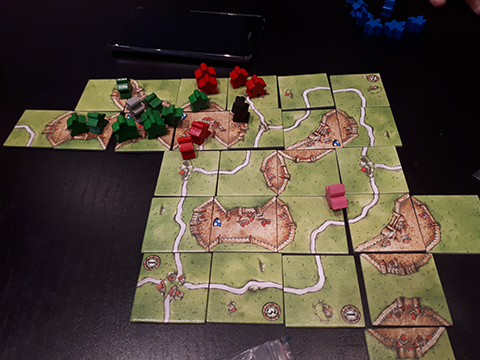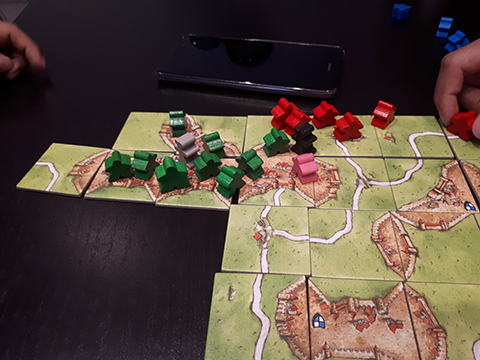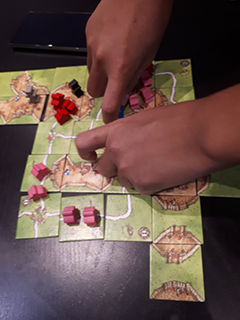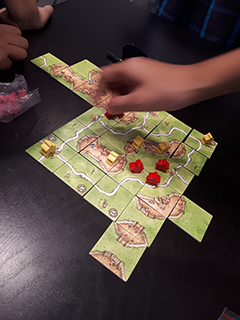Hi fellow youth leaders! What do the game of Carcassonne, water balloons, and Matthew 22 have in common? Glad you asked! Because, of course, they’re all part of our latest series of youth Bible lessons on the Parables of Jesus!
If you’re looking for full youth Bible lessons, or just a few ideas, keep reading! You can also download this lesson plan as a PDF here:
Preparation for Teaching your Youth Bible Lessons on Matthew 22
One of the absolute best things about teaching youth Bible lessons is that YOU get to learn an awful lot more about these amazing passages you’ve been reading your whole life! You might find it helpful to read through a couple of commentaries beforehand, so that you can learn some more about this passage before you teach it. One that I read through and found helpful is:
What to Bring to Teach the Lesson
-
-
- Enough Bibles for everyone
- Notes, especially for leading the discussion
- Game pieces from Carcassonne (if using the Carcassonne illustration)
- Water balloons – in pink, yellow, blue, red, green (one for each youth in the class)
- Blank paper for Pictionary game (enough for 7 pieces of paper for each group)
- Pens or markers for Pictionary game (enough for 1 for each group)
- Words for the Pictionary game pre-written (you can also download them here, so you don’t have to re-write them!!)
-
Now…On to the Teaching!
1. Scripture Reading
First up, start with the scripture reading. This just sets the tone for the remainder of the activities. You can have one youth member read the whole thing, or split the reading into two – perhaps have one youth read 7 verses, and then another youth read the second set of verses.
Jesus spoke to them again in parables, saying: 2 “The kingdom of heaven is like a king who prepared a wedding banquet for his son. 3 He sent his servants to those who had been invited to the banquet to tell them to come, but they refused to come.
4 “Then he sent some more servants and said, ‘Tell those who have been invited that I have prepared my dinner: My oxen and fattened cattle have been butchered, and everything is ready. Come to the wedding banquet.’
5 “But they paid no attention and went off—one to his field, another to his business. 6 The rest seized his servants, mistreated them and killed them. 7 The king was enraged. He sent his army and destroyed those murderers and burned their city.
8 “Then he said to his servants, ‘The wedding banquet is ready, but those I invited did not deserve to come. 9 So go to the street corners and invite to the banquet anyone you find.’ 10 So the servants went out into the streets and gathered all the people they could find, the bad as well as the good, and the wedding hall was filled with guests.
11 “But when the king came in to see the guests, he noticed a man there who was not wearing wedding clothes. 12 He asked, ‘How did you get in here without wedding clothes, friend?’ The man was speechless.
13 “Then the king told the attendants, ‘Tie him hand and foot, and throw him outside, into the darkness, where there will be weeping and gnashing of teeth.’
14 “For many are invited, but few are chosen.”
2. Warm-up Game
Move from the scripture right on into the warm-up game…which is….drumroll….Pictionary! It’s sooo important to play games whenever you’re teaching youth Bible lessons – they’re a bit old for many games and crafts out there – which means – we all have got to be super creative, don’t we!!
To make the Pictionary a little more exciting, a little faster paced, a little bit more fun – use this version:
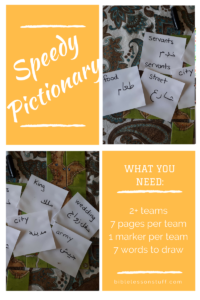
- Split your group into teams of 4-7 people each.
- Put each group around a different table, and give each table 7 sheets of paper and a marker/pen.
- Have one person from each group come up to you at the same time, and show them all the word they have to draw (all the words are from the scripture reading).
- Let the “drawers” go back to their groups, and on the count of 3 begin to draw. The first team to guess the word gets the point.
- Get everyone to stop drawing, and select a new “drawer” from each group, etc.
For this game of Pictionary, you can use the following words:
-
-
- food (or feast),
- servants,
- king,
- city,
- street,
- army,
- wedding.
-
If you want to download a Word template to just quickly print these words off, here you go: (note, that we teach our youth Bible lessons to a bilingual class of English and Arabic speakers, so I’ve made the template bilingual – feel free to change the words, or to add your own language!)
3. Lesson Illustration….Using Carcassonne!
You might have Carcassonne at home, or maybe not. Maybe you have Lego, maybe you have another game that has similar pieces – be creative! We found that this illustration was really helpful in understanding the different characters in the parable – and who they represent apart from the parable. Once again, not only games are super important – when teaching youth Bible lessons – object lessons or lesson illustrations are also golden – for keeping their attention. AND for helping them remember what was discussed. AND for helping them interpret what’s actually being taught.
First, set up the game board pieces to look like this:
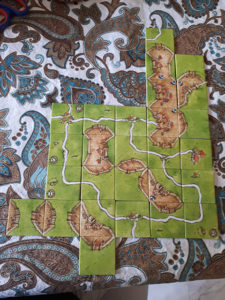
Then use different colored characters to represent the different characters in the story:
Black – the king
Gray – the king’s son
Red – the servants and attendants
Yellow – the first people invited to the wedding
Blue – the army
Pink – the people on the streets invited to the wedding – in their normal clothes
Green – the people from the streets who came to the wedding – in their wedding clothes
Just read through the story again, a couple verses at a time, and have a different youth in charge of each colour of character. As the story goes along, have the youth place their characters on the board to “act out” the story.
An important element of the story to capture is that when the people from the streets (the pink people) actually go to the wedding, they change their clothes into wedding garments (and become green people)…except for one person who goes to the feast still in his pink clothes!
Here are a few photos of the game board throughout the parable:
4. Discussion Questions
Once you’ve “acted out” the story, your youth will probably start to have a better understanding of the characters. It’s crucial in any of the youth Bible lessons you teach that you not only tell your youth what the story is about, but that you ask them. Well…cuz it makes them actually think!
And what are they thinking about? – a parable uses a story to illustrate a truth about the Kingdom of Heaven. So…
Who do each of the characters represent?
-
-
- Who does the king represent? (God?)
- Who does the king’s son represent? (Jesus?)
- Who do the servants represent? (disciples/followers/believers of Jesus and the King?)
- Who do the first people represent who were invited to the wedding? (Jews – God’s “chosen people”?)
- Who do the second group of people represent who were invited? (Gentiles – the good, the bad?)
-
Next, it’s really important to focus a bit on that one guy who came to the party in his normal clothes…
-
-
- What does the wedding invitation represent? (the good news, the gospel)
- When the people who came to the wedding changed their clothes into wedding garments, what does that represent in real life? (we are to take on the righteousness of Jesus, we are to accept the good news, and we become a new creation. This takes humility. It takes acceptance of our sin. It takes acceptance that we are invited to a Kingdom that we don’t deserve to be in!)
- What about the guy who came into the wedding in his normal clothes – who does he represent? (you know, sometimes we try to enter the Kingdom by our own means, without accepting Jesus, without accepting our sinfulness, without accepting God’s good gift. This is pride, arrogance – and it means we won’t be allowed to stay in the kingdom!)
-
You might want to also touch on the characters that didn’t get to stay in the kingdom a bit further:
-
-
- The final verse says “many are invited, but few are chosen” – what does that mean? (the first group of people who were invited never got to come to the party because they were more interested in their own lives, their own to-do lists; the guy who came to the party in his own clothes was too proud to accept the gift of the wedding garments – all these people never got to experience the fullness of life in the kingdom!)
-
And finally, end with some application…
-
-
- So, who are we in this story? (we might be a combination of those people on the streets, or new believers – people who have changed their clothes and entered the party, or we might be the servants, inviting other people to come in. Or…we might be those who have rejected the invitation, or who have entered the Kingdom with our friends without accepting Christ.)
- Has anyone ever shared the gospel, or the invitation, with anyone before? How does it make you feel? (it’s exciting to share about Jesus, but it also is a bit scary. Also, you might not want to share it with “bad” people. But remember in the story that the “bad” people actually were some of the ones who got to enter the kingdom in new clothes, who accepted the invitation! This should be an encouragement.)
-
5. Prayer
When you’re ending any of your youth Bible lessons, it’s important to close off, or spend a bit of time, in prayer. It’s a great way to disciple your youth, to set an example, and to try to get them thinking about the application of the lesson to their lives, their world.
-
-
- Place a bucket of pink, yellow, blue, red, and green water balloons in the middle of the class.
- Have each youth take a balloon.
- Explain that you’ll be doing a popcorn prayer – and that each youth can pray one sentence out loud.
- The colour of the balloon they’re holding represents who they can pray for (taken from the illustration):
- Pink: pray for people who have never heard the gospel before
- Yellow: pray for people who are “too busy” to listen to the gospel, that their hearts can be changed
- Blue: pray for all the war going on in the world – pray for soldiers and victims – that God can bring an end to war, that he can protect the innocent
- Red: pray for people such as missionaries, or people who are sharing the gospel with their friends
- Green: pray for new believers – that they will be encouraged and continue to grow in their faith
-
What’s the purpose of the water balloons? Well – don’t let them burst the balloons in class – but as we’re in the middle of summer right now – let them have the balloons as a “takeaway” from the lesson – and you’re not responsible for how they end up using them 😉
6. Wrap-up – The “Point”…
So, what’s this parable and these youth Bible lessons on Matthew 22 all about really?
-
-
- It’s about sharing the gospel
- And it’s about our own response to the good news!
-
Thank you!
Fellow youth workers – hope you enjoyed this lesson plan! If you want to try out more of our youth Bible lessons, you can try this one as well, on Facing Your Fears! If you tried any different versions of this lesson, or used these ideas with different passages, can you share with me? It’s great to share creativity with one another in sharing God’s word with youth!! And don’t forget – if you want to download this as a free PDF lesson plan, please click here:

